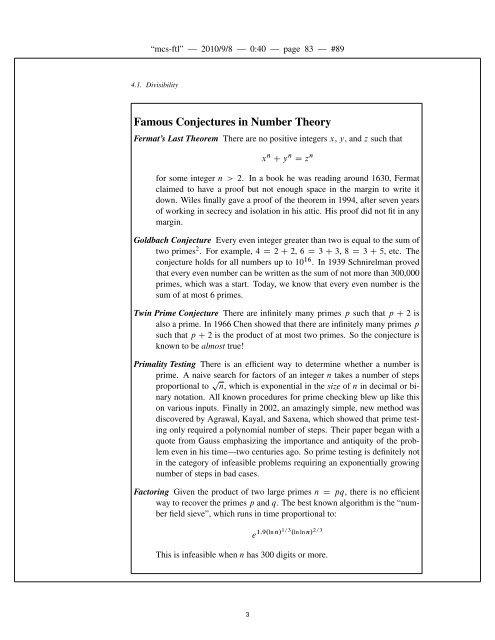6.042J Chapter 4: Number theory - MIT OpenCourseWare
6.042J Chapter 4: Number theory - MIT OpenCourseWare
6.042J Chapter 4: Number theory - MIT OpenCourseWare
You also want an ePaper? Increase the reach of your titles
YUMPU automatically turns print PDFs into web optimized ePapers that Google loves.
“mcs-ftl” — 2010/9/8 — 0:40 — page 83 — #894.1. DivisibilityFamous Conjectures in <strong>Number</strong> TheoryFermat’s Last Theorem There are no positive integers x, y, and z such thatx n C y n D z nfor some integer n > 2. In a book he was reading around 1630, Fermatclaimed to have a proof but not enough space in the margin to write itdown. Wiles finally gave a proof of the theorem in 1994, after seven yearsof working in secrecy and isolation in his attic. His proof did not fit in anymargin.Goldbach Conjecture Every even integer greater than two is equal to the sum oftwo primes 2 . For example, 4 D 2 C 2, 6 D 3 C 3, 8 D 3 C 5, etc. Theconjecture holds for all numbers up to 10 16 . In 1939 Schnirelman provedthat every even number can be written as the sum of not more than 300,000primes, which was a start. Today, we know that every even number is thesum of at most 6 primes.Twin Prime Conjecture There are infinitely many primes p such that p C 2 isalso a prime. In 1966 Chen showed that there are infinitely many primes psuch that p C 2 is the product of at most two primes. So the conjecture isknown to be almost true!Primality Testing There is an efficient way to determine whether a number isprime. A naive search for factors of an integer n takes a number of stepsproportional to p n, which is exponential in the size of n in decimal or binarynotation. All known procedures for prime checking blew up like thison various inputs. Finally in 2002, an amazingly simple, new method wasdiscovered by Agrawal, Kayal, and Saxena, which showed that prime testingonly required a polynomial number of steps. Their paper began with aquote from Gauss emphasizing the importance and antiquity of the problemeven in his time—two centuries ago. So prime testing is definitely notin the category of infeasible problems requiring an exponentially growingnumber of steps in bad cases.Factoring Given the product of two large primes n D pq, there is no efficientway to recover the primes p and q. The best known algorithm is the “numberfield sieve”, which runs in time proportional to:e 1:9.ln n/1=3 .ln ln n/ 2=3This is infeasible when n has 300 digits or more.3
















